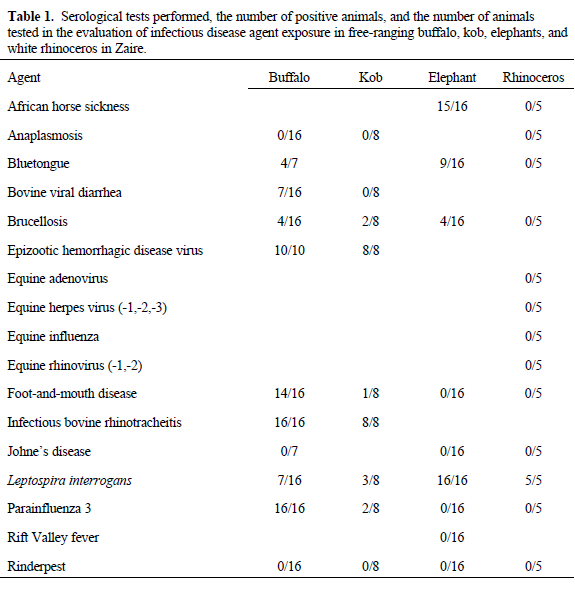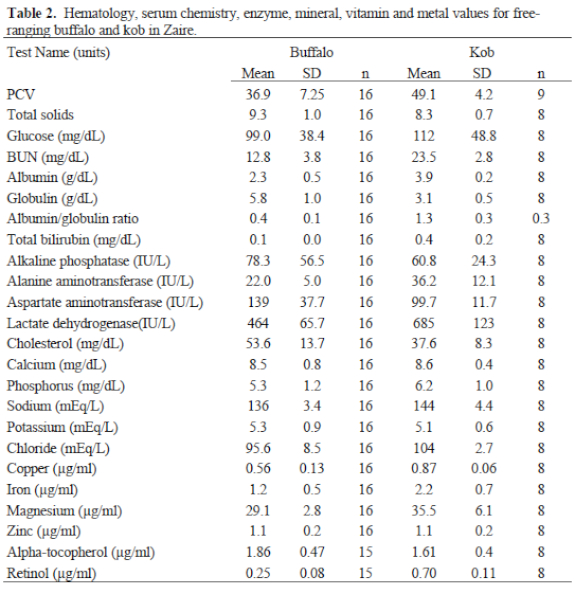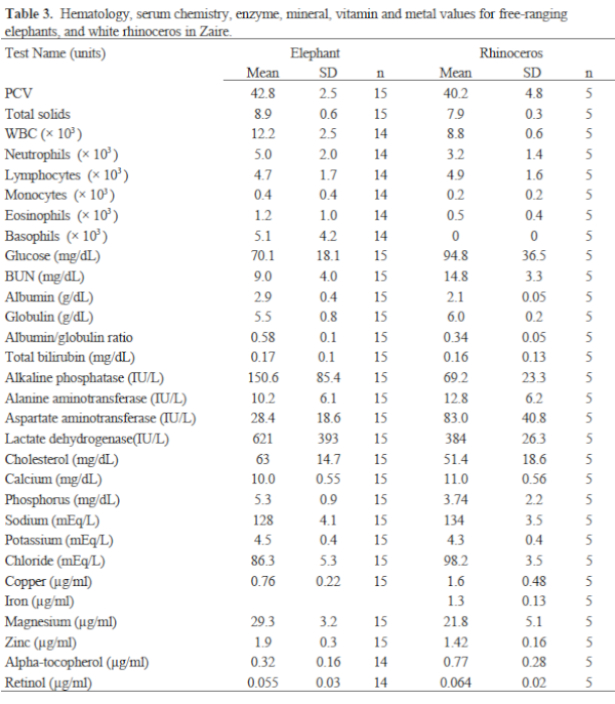Elephants, Buffalo, Kob, and Rhinoceros: Immobilization, Telemetry and Health Evaluations
Abstract
From 1992 through 1996, African elephants (Loxodonta africana), savanna buffalo (Syncerus caffer), Ugandan kob (Kobus kob), and northern white rhinoceros (Ceratotherium simum cottoni) were immobilized for health evaluations or radio-telemetry studies at Garamba National Park in northeastern Zaire.
Thirty-seven elephants were darted for immobilization using either 50-caliber metal darts and 3.1 or 5.0x60 mm (Palmer Chemical & Equipment Co., Inc., Douglasville, GA, USA) or 3-ml plastic darts and 2.0x60-mm needles (Telinject USA, Saugus, CA, USA). Four calves, 4–6 years old, were immobilized using 1 mg of carfentanil hydrochloride (Wildlife Pharmaceuticals, Fort Collins, CO, USA). Adults were immobilized with 3 mg of carfentanil mixed with 1500 IU of hyaluronidase. All animals were reversed with naltrexone hydrochloride (Wildlife Pharmaceuticals, Fort Collins, CO, USA) at a rate of 100 mg for every mg of carfentanil used. Failure of the darts to inject properly occurred in 15 cases. For animals responding completely to the first darting attempt, mean minutes elapsed for initial effect or standing still, recumbency, and recovery following reversal were 5.0±1.6, 10.7±3.9, and 5.9±3.9, respectively.
Sixteen adult buffalo were immobilized using 3-ml Telinject plastic darts with 2.0x60-mm needles and 5 mg of carfentanil. Failure of the darts to inject properly occurred in two cases. For animals responding completely to the first darting attempt, mean minutes elapsed for initial effect or standing still, recumbency, and recovery following reversal were 2.0±0.6, 4.3±2.4, and 3.9±2.6, respectively.
Eleven adult kob were immobilized using 3-ml Telinject plastic darts with 1.5x38-mm collared needles and 2 mg of carfentanil. Failure of the darts to inject properly occurred in five cases. For animals responding completely to the first darting attempt, mean minutes elapsed for initial effect or standing still, recumbency, and recovery following reversal were 2.7±0.7, 6.5±4.1, and 1.2±0.4, respectively.
Nine rhinoceros were darted with 50-caliber metal darts and 60-mm needles made by the South Africa National Parks Board using a combination of etorphine (2–3.8 mg) and detomidine (9–16 mg). Failure of the darts to inject properly occurred in three cases. For animals responding completely to the first darting attempt, mean minutes elapsed for initial effect or standing still, recumbency, and recovery following reversal were 5.2±2.5, 8.0±3.0, and 1.7±0.7, respectively.
Packed cell volumes, total protein, and white blood cell counts were conducted in the field, and serum was frozen in liquid nitrogen. Serum chemistries and enzymes were processed on an automated analyzer. Plasma samples were analyzed for vitamin E (α-tocopherol) and vitamin A (retinol) using high-performance liquid chromatography. Plasma samples were analyzed for aluminum, boron, barium, copper, cobalt, iron, magnesium, manganese, molybdenum, and zinc by inductively coupled argon plasma emission spectroscopy. Plasma was also analyzed for polychlorinated biphenyls and the following chlorinated pesticides: aldrin; alpha-BHC; beta-BHC; O, P’-DDD; P, P’-DDD; P, P’-DDE; O, P’-DDT; P, P’-DDT; dieldrin; endrin; heptachlor; heptachlor epoxide; and Lindane (gamma-BHC). Serological tests are listed in Table 1.

Four elephants were fitted with standard VHF radio transmitters (Advanced Telemetry Systems, Inc., Isanti, MN, USA) mounted on collars made of 75-mm-wide machine belting. One elephant was fitted with a transmitter utilizing the ARGOS satellite system (Telonics, Mesa, AZ, USA). Four rhinoceros were fitted with VHF radio collars (Telonics), and five had VHF radio transmitters (Advanced Telemetry Systems) implanted in their horns. This was accomplished by drilling a 35-mm-diameter hole transversely near the base of the horn and a 5-mm hole from the horn tip down to meet the transverse hole. The transmitter was inserted in the larger hole with the antenna being fed up through the lengthwise hole. Dental acrylic was used to fill and seal the cavities.
No ectoparasites were found on the elephants or kob. No evidence of gastrointestinal parasites was found in fecal samples from the elephants. Samples from kob showed coccidia, strongyles, or trematodes. All buffalo were heavily infested with ticks (Amblyomma cohaerens and Rhipicephalus longus). Fecal samples from buffalo showed coccidia, strongyles, and/or trematodes. Rhinoceros were found to have light infestations of ticks (Amblyomma cohaerens, Dermacentor rhinocerinus, and Rhipicephalus senegalensis), about 20–100 ticks/animal. Fecal samples from the rhinoceros revealed strongyles, strongyloides-like larvae, coccidia, and in one individual sample, ascarid ova.
Hematologic, biochemical, and vitamin and mineral test results for buffalo and kob, and for elephant and rhinoceros are in Tables 2 and 3, respectively. Levels for Al (<1.66 ppm), B (<1.66 ppm), Co (<0.167 ppm), Mn (<0.083 ppm), and Mo (<0.33 ppm) were below accurate detectable limits. All chlorinated pesticide and polychlorinated biphenyl analyses were below detectable limits (0.001–0.007 ppm and 0.05 ppm, respectively). Infectious disease serology results are provided in Table 1.

